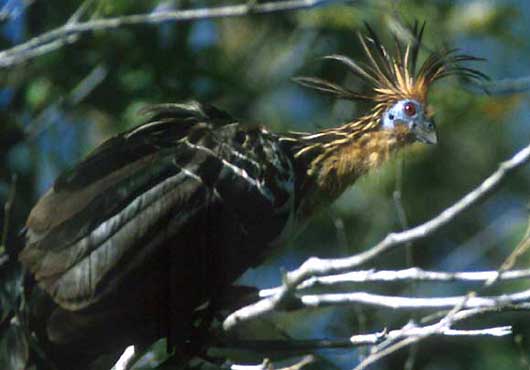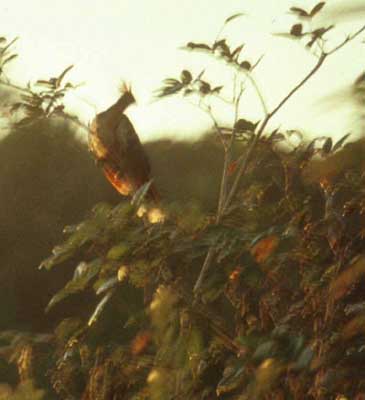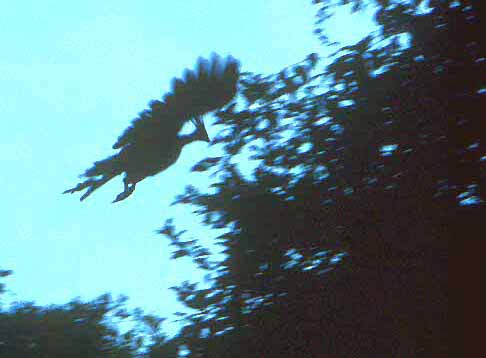HOATZIN Opisthocomidae
- Species in family 1
- Species observed [DR] 1 (100%)
- Species photo'd [DR] 1
 The Hoatzin (left and below) is a very odd, monotypic species
of uncertain affinities which lives in backwater swamps of the Amazon and
Orinoco basins of South America. It is often considered one of the most
primitive of birds. While it is not difficult to find Hoatzins once their
habitat is reached, I have had much difficulty in taking photos. The fine lead
photo (above left) was taken by Bill Rydell in the Hato Piñero region of
the Venezuelan llanos, and shows the odd pear-like shape, the bare face, and the
shaggy crest of this unique bird. My own efforts (below or right) from
Peru and Brazil record not much more than brief, enigmatic images of a strange
bird in a strange place. One can almost feel the muggy dank air of each
swamp, and the whine of hundreds of mosquitos...
The Hoatzin (left and below) is a very odd, monotypic species
of uncertain affinities which lives in backwater swamps of the Amazon and
Orinoco basins of South America. It is often considered one of the most
primitive of birds. While it is not difficult to find Hoatzins once their
habitat is reached, I have had much difficulty in taking photos. The fine lead
photo (above left) was taken by Bill Rydell in the Hato Piñero region of
the Venezuelan llanos, and shows the odd pear-like shape, the bare face, and the
shaggy crest of this unique bird. My own efforts (below or right) from
Peru and Brazil record not much more than brief, enigmatic images of a strange
bird in a strange place. One can almost feel the muggy dank air of each
swamp, and the whine of hundreds of mosquitos...
 The Hoatzin is strictly vegetarian, eating the leaves,
flowers and fruits of more than 50 species of marshland plants. Hoatzins are
very strange among birds, though, because they ferment this vegetable matter in
their foregut like cows, sheep, deer and kangaroos, and thus have a specialized
digestive system. Nestlings are fed this regurgitated matter. Hoatzins forage in
the early morning and early evening, and spend much of the time roosting quietly
and digesting their meal.
The Hoatzin is strictly vegetarian, eating the leaves,
flowers and fruits of more than 50 species of marshland plants. Hoatzins are
very strange among birds, though, because they ferment this vegetable matter in
their foregut like cows, sheep, deer and kangaroos, and thus have a specialized
digestive system. Nestlings are fed this regurgitated matter. Hoatzins forage in
the early morning and early evening, and spend much of the time roosting quietly
and digesting their meal.
The Hoatzin chick feathers a rare anatomical feature -- two claws on each
budding wing which help it grip branches and clamber about awkwardly. This
feature has been compared to Archaeopteryx, the fossil proto-bird, and
lend a antediluvian background to what is already a really weird bird. Great
photos are in Thomas (1996) and fantastic video of adult and young Hoatzins is
in David Attenborough's "Life of Birds" series.
Hoatzins live in family groups and small aggregations (up to 40 birds) and
are social throughout the year. During breeding birds occupy densely packed
exclusive territories, sometimes up to 28 nests in one tree. They are noisy and
often vocalize in unison with a collection of hoarse cries, grunts, growls and
hisses.
Hoatzins are limited to their lowland swamp habitat. Old cut-off river
channels and backwater lagoons are appropriate, but they avoid swift-moving
water. Thus in many riverine places in South America, Hoatzins will be found
only in a few well-known places. Many jungle lodges will offer boat trips to see
Hoatzins although in some places (like La Selva Lodge, Ecuador) they are right
at the main boat dock.
Hoatzins are poor fliers, and they put a lot of noisy effort into using their
broad rusty wings to cross channels or move away from perceived danger (below).
 The affinities and relationship of the Hoatzin have been
the subject of much debate over the years. They have variously been grouped with
the cranes, rails, tinamous, sandgrouse, doves, mousebirds or seriemas. The more
conservative systematists still retain the Hoatzin in the Galliformes, based on
osteological and immunological data (Thomas 1996). Recent biochemical evidence
(both egg white proteins and DNA-DNA hybridization; Sibley & Ahlquist 1990)
and behavioral studies have shown an affinity with the Cuculiformes (cuckoos and
relatives), and Sibley & Monroe (1990) consider it within a "parvorder" in
the midst of their various cuckoo/ani groupings. One objection to this
arrangement, however, is that hoatzins have anisodactyl feet (three toes
forward, one backwards) like most birds, rather than the zygodactyl feet (two
toes forward, two backward) of all the other cuckoos. Thus, whatever their
relatives may be, they are unique and odd birds, and well deserving of the
attention showered on them by visiting birdwatchers to South America.
The affinities and relationship of the Hoatzin have been
the subject of much debate over the years. They have variously been grouped with
the cranes, rails, tinamous, sandgrouse, doves, mousebirds or seriemas. The more
conservative systematists still retain the Hoatzin in the Galliformes, based on
osteological and immunological data (Thomas 1996). Recent biochemical evidence
(both egg white proteins and DNA-DNA hybridization; Sibley & Ahlquist 1990)
and behavioral studies have shown an affinity with the Cuculiformes (cuckoos and
relatives), and Sibley & Monroe (1990) consider it within a "parvorder" in
the midst of their various cuckoo/ani groupings. One objection to this
arrangement, however, is that hoatzins have anisodactyl feet (three toes
forward, one backwards) like most birds, rather than the zygodactyl feet (two
toes forward, two backward) of all the other cuckoos. Thus, whatever their
relatives may be, they are unique and odd birds, and well deserving of the
attention showered on them by visiting birdwatchers to South America.
Photos: The upper photo of a Hoatzin
Opisthocomus hoazin was taken by Bill Rydell in the Hato Piñero area of
south-central Venezuela in Feb 2000. The "hoatzin at dawn" shot was from
Tambopata Nature Reserve, Madre de Dios, Peru, in June 1987. The flight shot of
a hoatzin dashing across a small gap in the foliage was along the upper Rio
Cristalino River, n. Mato Grosso, Brazil, in August 1999. Upper
photo © 2000 Bill Rydell (used with permission), lower photos © 2000 Don
Roberson; all rights reserved.
Bibliographic note:
There is no "family book" per se of which I'm aware, but an excellent
introduction to the family -- including some wonderful photos -- is in Thomas
(1996).
Literature cited:
Sibley, C. G., and J. E. Ahlquist. 1990. Phylogeny and
Classification of Birds: A Study in Molecular Evolution. Yale Univ. Press, New
Haven, CT.
Sibley, C. G., and B. L. Monroe, Jr. 1990. Distribution and Taxonomy of
Birds of the World. Yale Univ. Press, New Haven, CT.
Thomas, B. T. 1996. Family Opisthocomidae (Hoatzin) in del Hoyo, J.,
Elliott, A., & Sargatal, J., eds. Handbook of the Birds of the
World. Vol. 3. Lynx Edicions, Barcelona.
 The Hoatzin is strictly vegetarian, eating the leaves,
flowers and fruits of more than 50 species of marshland plants. Hoatzins are
very strange among birds, though, because they ferment this vegetable matter in
their foregut like cows, sheep, deer and kangaroos, and thus have a specialized
digestive system. Nestlings are fed this regurgitated matter. Hoatzins forage in
the early morning and early evening, and spend much of the time roosting quietly
and digesting their meal.
The Hoatzin is strictly vegetarian, eating the leaves,
flowers and fruits of more than 50 species of marshland plants. Hoatzins are
very strange among birds, though, because they ferment this vegetable matter in
their foregut like cows, sheep, deer and kangaroos, and thus have a specialized
digestive system. Nestlings are fed this regurgitated matter. Hoatzins forage in
the early morning and early evening, and spend much of the time roosting quietly
and digesting their meal.
 The Hoatzin (left and below) is a very odd, monotypic species
of uncertain affinities which lives in backwater swamps of the Amazon and
Orinoco basins of South America. It is often considered one of the most
primitive of birds. While it is not difficult to find Hoatzins once their
habitat is reached, I have had much difficulty in taking photos. The fine lead
photo (above left) was taken by Bill Rydell in the Hato Piñero region of
the Venezuelan llanos, and shows the odd pear-like shape, the bare face, and the
shaggy crest of this unique bird. My own efforts (below or right) from
Peru and Brazil record not much more than brief, enigmatic images of a strange
bird in a strange place. One can almost feel the muggy dank air of each
swamp, and the whine of hundreds of mosquitos...
The Hoatzin (left and below) is a very odd, monotypic species
of uncertain affinities which lives in backwater swamps of the Amazon and
Orinoco basins of South America. It is often considered one of the most
primitive of birds. While it is not difficult to find Hoatzins once their
habitat is reached, I have had much difficulty in taking photos. The fine lead
photo (above left) was taken by Bill Rydell in the Hato Piñero region of
the Venezuelan llanos, and shows the odd pear-like shape, the bare face, and the
shaggy crest of this unique bird. My own efforts (below or right) from
Peru and Brazil record not much more than brief, enigmatic images of a strange
bird in a strange place. One can almost feel the muggy dank air of each
swamp, and the whine of hundreds of mosquitos...
 The affinities and relationship of the Hoatzin have been
the subject of much debate over the years. They have variously been grouped with
the cranes, rails, tinamous, sandgrouse, doves, mousebirds or seriemas. The more
conservative systematists still retain the Hoatzin in the Galliformes, based on
osteological and immunological data (Thomas 1996). Recent biochemical evidence
(both egg white proteins and DNA-DNA hybridization; Sibley & Ahlquist 1990)
and behavioral studies have shown an affinity with the Cuculiformes (cuckoos and
relatives), and Sibley & Monroe (1990) consider it within a "parvorder" in
the midst of their various cuckoo/ani groupings. One objection to this
arrangement, however, is that hoatzins have anisodactyl feet (three toes
forward, one backwards) like most birds, rather than the zygodactyl feet (two
toes forward, two backward) of all the other cuckoos. Thus, whatever their
relatives may be, they are unique and odd birds, and well deserving of the
attention showered on them by visiting birdwatchers to South America.
The affinities and relationship of the Hoatzin have been
the subject of much debate over the years. They have variously been grouped with
the cranes, rails, tinamous, sandgrouse, doves, mousebirds or seriemas. The more
conservative systematists still retain the Hoatzin in the Galliformes, based on
osteological and immunological data (Thomas 1996). Recent biochemical evidence
(both egg white proteins and DNA-DNA hybridization; Sibley & Ahlquist 1990)
and behavioral studies have shown an affinity with the Cuculiformes (cuckoos and
relatives), and Sibley & Monroe (1990) consider it within a "parvorder" in
the midst of their various cuckoo/ani groupings. One objection to this
arrangement, however, is that hoatzins have anisodactyl feet (three toes
forward, one backwards) like most birds, rather than the zygodactyl feet (two
toes forward, two backward) of all the other cuckoos. Thus, whatever their
relatives may be, they are unique and odd birds, and well deserving of the
attention showered on them by visiting birdwatchers to South America.